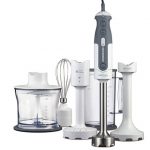A stick blender, also known as an immersion blender, wand blender or hand blender, is basically a stick or wand with a blender blade on one end and a switch on the other. It is held in the hand and the blender tip inserted into whatever container you are using to blend, stir, puree, emulsify or chop your ingredients. These small blenders are very versatile, easy and quick to use and can be kept close at hand. They are generally cheaper than a standard blender and are small and easy to store close at hand.
Because the stick or wand blender can be used directing into your cooking pot, bowl or jug, there is no need to transfer batches of ingredients to a benchtop blender jar and then, once blended, into a second pot bowl or jug. This really saves on time, washing up and removes the danger of burns from lifting heavy pots of hot ingredients like soup.
- Quick and easy to blend or puree food
- Blend in whatever container suits your ingredients
- Less danger of spilling hot liquids by blending in the cooking pot
- Less pots or bowls to wash up
- Easy to clean
- Easy to store
- Easy to keep close at hand
- Inexpensive compared to larger blenders
- Cordless models available to take anywhere
- Not the best for blending or pureeing stiff or tough foods
- Only suitable for chopping, crushing or grinding small amounts at a time
- Care needs to be taken to avoid splashing, especially hot foods such as soup
- Not appropriate for children to use
Featured Stick Blender Reviews
Features of Stick Blenders
Small and light – Stick blenders are easy to hold and use in one hand.
Easy to clean – You can just dip into soapy water and whiz clean or toss the bottom parts in the dishwasher.
In-container use – Use directly in the pot or bowl you are cooking in.
Blend hot ingredients – Most stick blenders can be used in hot liquids like soup.
Easy to store – Stick blenders are small enough to store in a drawer, cupboard or even hang in a wall bracket.
Different blades – You can get special blades to puree, whip or chop. Some stick blenders can even be converted into small food processors with an attachment.
Stick Blender Uses
Stick or wand blenders excel at:
- Making sauces, vinaigrettes and mayonnaises
- Whipping cream
- Making smoothies and milk shakes
- Blending soups
- Chopping small quantities of herbs or nuts
Stick Blender Attachments
Stick blenders can come with various attachments. These may include:
- Special blades or attachments for blending, pureeing, chopping or shredding
- Whipping or beating attachment
- Whisk attachment
- Chopper bowl/mini food processor
- Jug or jar that is perfect to whip or chop small quantities, and may even have a lid for storage
- Wall bracket, storage case or stand
- Extension wand for blending in large containers
What to look for when buying a Stick Blender
Power
Stick blenders come in a range of Wattage, from 140 – 800 watts. If you only want to blend thin liquids or to make smoothies, then a low powered and therefore cheaper immersion blender would suit you. However, if you want to be able to puree thicker liquids, grind nuts and seeds, crush ice and chop fruit and herbs you should get a more powerful model.
Speed Settings
Some stick blenders have only 2 speeds, while some have variable and some have a turbo setting.
Pulse Option
This can be useful when grinding or crushing to give short bursts of power to redistribute the contents and give a more consistent result.
Wand Length
Some brands have models with different wand lengths and some have extension wands for using in deeper containers.
Corded or Cordless
Corded stick blenders will have more and longer lasting power. Make sure the cord is long enough to reach the areas where you would use it. A cordless stick blender is more manoeuvrable and you don’t have to worry about the cord getting in your way as you move around, but the battery will make it heavier to hold and you will have less wattage. Plus with cordless the battery will lose power and require recharging. So cordless are good for quick light blending, but for anything more serious a corded stick blender is the better option.
Design
Check the feel of the immersion blender in your hand, the fit, the weight, how balanced it feels and how easy it is to use the controls as you hold it.
Cleaning
Some stick blenders have removable dishwasher safe wands and attachments to make cleaning quick and easy.

